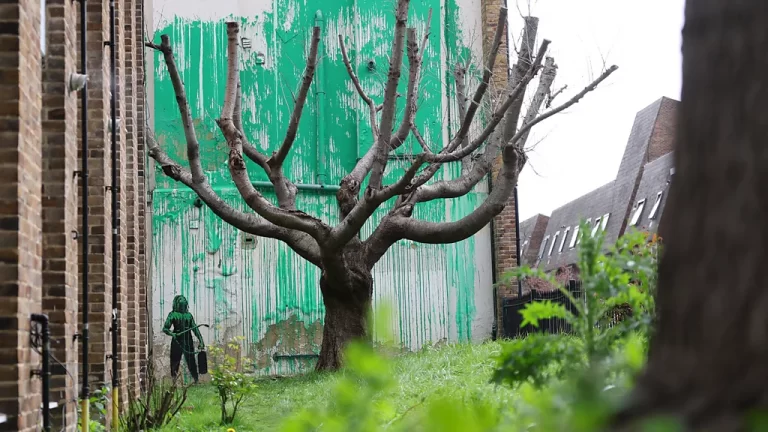With a new mural that appeared in London on Sunday, and which only makes sense from a distance, the elusive British street artist is playing with our perspective.
In a grey North London street on Monday, people gathered aimlessly, pointing their phones at a wall. Up close, however, the artwork on the wall they were photographing didn't make much sense. That's the point of Banksy's latest offering – it demands distance. When attempting a selfie, jostling for a solo spot in an Insta-crowd, that's hard to achieve. Yet stand too close, and it just looks like you're taking a selfie in front of some green splatter.
Banksy – who hasn't revealed his identity, but is one of the world's most famous artists – yesterday confirmed he was the creator of a mural that popped up on Sunday in Finsbury Park, Islington. Behind a bare cherry tree next to a block of flats, a wall has been sprayed with green paint.
Despite parks a few streets away, there's not a lot of nature to look at on this section of Hornsey Road. It's an urban neighbourhood, in what its MP (and former Labour leader) Jeremy Corbyn described as “the most densely populated constituency in the country”.
The further you get from Banksy's mural, the more it appears to add a touch of the bucolic. Approaching from Crouch End, there's a moment when the tree looks to be in full leaf. Squint from a block away, and it's a cartoon version of utopia in N19.

Up close, however, it's spindly black branches against a wall of green dribbles, ending in a stencilled figure (typical of Banksy's work) peering up, as if wondering what all the fuss is about.
It's now become an event whenever a new piece of Banksy's appears in an urban street, and there's an associated risk for the artist – one that James Peak, who created the BBC Radio 4 series The Banksy Story, flagged yesterday: Banksy has “an emerging problem” of people trying to steal his work.
A stop sign that had been adapted by Banksy was removed an hour after it appeared in Peckham, South London, on 22 December 2023. Two men were arrested on suspicion of theft and criminal damage in relation to the sign, which was decorated with three military drones and could be worth up to £500,000.
Yet with the street artist incorporating a tree into his work, Peak told the BBC, “I don't think anyone is going to be able to nick this… how are you going to steal a tree?”
And the tree's central purpose in the mural places Banksy's work adjacent to the tradition of anamorphic artworks that require the viewer to stand at a certain vantage point – such as The Ambassadors (c 1533) by Hans Holbein the Younger. What initially appears to be an odd grey slash across the bottom of the painting is revealed to be a skull when seen from a particular angle.
Later techniques included Baroque trompe-l'œil murals that combined real architecture with painted illusions to create a seamless effect from a specific viewpoint, such as Andrea Pozzo's Fake Dome in the Church of St Ignatius in Rome, and anamorphosis and foreshortening in paintings by the Surrealist artist Salvador Dalí.
The psychoanalyst Jacques Lacan commented in On the Gaze as Object Petit A (1973) that the use of anamorphosis, especially in The Ambassadors, is one of the few methods by which viewers can be made aware of their gaze – he argued that the initial “moment of seeing”, as when perceiving the skull in Holbein's painting for the first time, is the closest people can get to an awareness of their gaze.
Whether it's a tiny stencil or a four-storey mural (painted in the particular shade of green used by Islington council in local signs), Banksy's street art has the ability to shift the viewer's perspective – something that his latest work plays on.

By creating an abstract image that's hard to steal, and which relies on a decaying tree to make sense, the elusive artist has transformed an urban landscape. In a decidedly unleafy grove of North London, green splatters across a wall coalesce. It might not convince up close, but viewed from the end of the block and over the heads of selfie-takers, the mural offers something else – it gives the pollarded cherry tree in the tiny front yard of an apartment block a sense of hope. And those of us who walk past it, day after day, a sense of what could be, if we shifted our perspective.
— CutC by bbc.com


